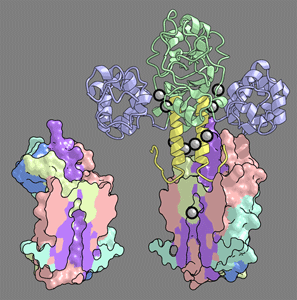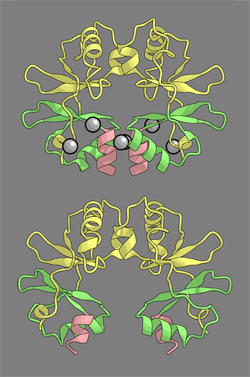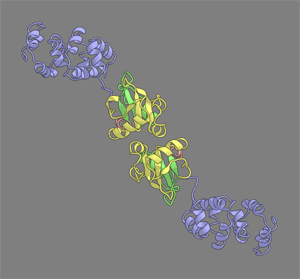Magnesium ion transporter MgtE
The magnesium ion Mg
2+ is a vital element involved in numerous physiological processes. Mg
2+ has the largest hydrated radius among all cations, whereas its ionic radius is the smallest. It remains obscure how Mg
2+ transporters selectively recognize and dehydrate the large, fully hydrated Mg
2+ cation for transport. We determine the crystal structures of the full-length Thermus thermophilus MgtE at 3.5 Å resolution, and of the cytosolic domain in the presence and absence of Mg
2+ at 2.3 Å and 3.9 Å resolutions, respectively.
 |
| The transporter adopts a homodimeric architecture, consisting of the carboxy-terminal five transmembrane domains and the amino-terminal cytosolic domains, which are composed of the superhelical N domain and tandemly repeated cystathionine-beta-synthase domains. A solvent-accessible pore nearly traverses the transmembrane domains, with one potential Mg2+ bound to the conserved Asp 432 within the pore. The transmembrane (TM)5 helices from both subunits close the pore through interactions with the 'connecting helices', which connect the cystathionine-beta-synthase and transmembrane domains. Four putative Mg2+ ions are bound at the interface between the connecting helices and the other domains, and this may lock the closed conformation of the pore.
|
 |
A structural comparison of the two states of the cytosolic domains showed the Mg2+-dependent movement of the connecting helices, which might reorganize the transmembrane helices to open the pore. These findings suggest a homeostasis mechanism, in which Mg2+ bound between cytosolic domains regulates Mg2+ flux by sensing the intracellular Mg2+ concentration. Whether this presumed regulation controls gating of an ion channel or opening of a secondary active transporter remains to be determined.
|
Gallery



![[XXX]](/image/tw.png)